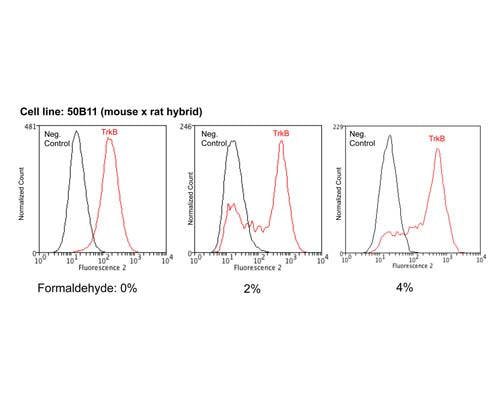Anti-Tyrosine Kinase Receptor B (TrkB) Antibody (BS379)
Our Anti-Tyrosine Kinase Receptor B (TrkB) mouse monoclonal primary antibody detects human, mouse, and rat Tyrosine Kinase Receptor B (TrkB), and is IgG. It is validated for use in FC.


TrkB expression (red) in 50B11 mouse x rat hybrid cell line analysed by Flow Cytometry. Fixation: 0 ,2 and 4% formaldehyde in PBS, pH 7.2-7.6 on ice (10 minutes). Blocking: 100 µg/mL normal sheep IgG in PBS (30 minutes) on ice. Primary antibody: TrkB clone BS379 (10 µg/mL) for 60 minutes on ice. Secondary antibody: Goat anti-rabbit PE (1:100 dilution), 30 min in dark on ice. Non-specific control IgG clone X63 (black) was used as negative control under same conditions. Flow cytometry data and results were generated using Orflo MoxiflowTM instrument and protocols.
Click on image to zoom
SKU: M-1836-100
Product Details
Tyrosine Kinase Receptor B (TrkB)
The protein named TrkB (also named Neurotrophic tyrosine kinase receptor type 2 (NTRK2), GP145-TrkB or Tropomyosin-related kinase B is a receptor tyrosine kinase involved in the development and the maturation of the central and the peripheral nervous systems and is important in the regulation of neuron survival, proliferation, migration, differentiation, and synapse formation and plasticity. TrkB may also play a role in neutrophin-dependent calcium signaling in glial cells and mediate communication between neurons and glia. TrkB is the primary receptor for BDNF (brain-derived neurotrophic factor. TrkB also binds NT4 and NT3 but less efficiently. Upon ligand-binding, the receptor undergoes homodimerization, autophosphorylation and activation. TrkB activation recruits, phosphorylates and/or activates several downstream effectors including SHC1, FRS2, SH2B1, SH2B2 and PLCG1 that each regulate distinct overlapping signaling cascades within cells. Through SHC1, FRS2, SH2B1, SH2B2, these activate the GRB2-Ras-MAPK cascade that regulates, for instance, neuronal differentiation including neurite outgrowth. These same effectors also control the Ras-PI3 kinase-AKT1 signaling cascade that mainly regulates growth and survival. TrkB, via activation of PLCG1 and the downstream protein kinase C-regulated pathways, also controls synaptic plasticity, and thus plays a role in learning and memory by regulating both short term synaptic function and long-term potentiation. PLCG1 also leads to NF-Kappa-B activation and the transcription of genes involved in cell survival. One such consequence is that PLCG1 activation via TrkB is able to suppress anoikis, the apoptosis resulting from loss of cell-matrix interactions. (Reference: www.uniprot.org)
IgG
Monoclonal
BS379
Flow
Mouse
Synthetic peptide immunogen, ESSKNIPLANLQ. Extracellular domain of TrkB (amino acids 179-190 of human TrkB).
Human
Human, Mouse, Rat
Spin vial briefly before opening. Reconstitute in 100 uL sterile-filtered, ultrapure water to obtain an antibody concentration of 1 mg/mL. Centrifuge to remove any insoluble material. Store lyophilized antibody at 2-8°C. After reconstitution divide into aliquots and store at -20°C for long-term storage. Store at 2-8°C short-term (up to 4 weeks). Avoid repetitive freeze/thaw cycles.
Lyophilized
Protein G purified
Lyophilized from PBS, pH 7.2-7.6 with 0.1% trehalose.
Flow Cytometry (5-10 µg/mL): Tested on human and rodent cell lines. Cell staining can be performed under native conditions on ice, or on fixed cells with up to 4% formaldehyde. Other applications have not been tested.
Unconjugated
TrkB; detects TrkB in both human, mouse and rat samples by Flow cytometry.
For research use only.
United States
12 months after date of receipt (unopened vial).
GP145-TrkB, Trk-B;Neurotrophic tyrosine kinase receptor type 2;TrkB tyrosine kinase;Tropomyosin-related kinase B;Gene Name:NTRK2
25°C (ambient)


